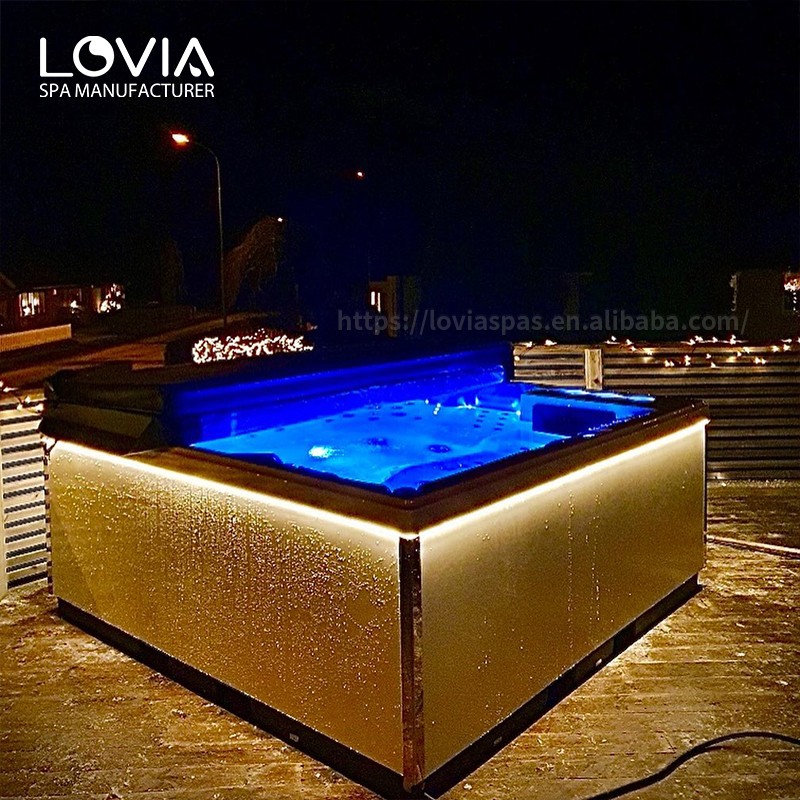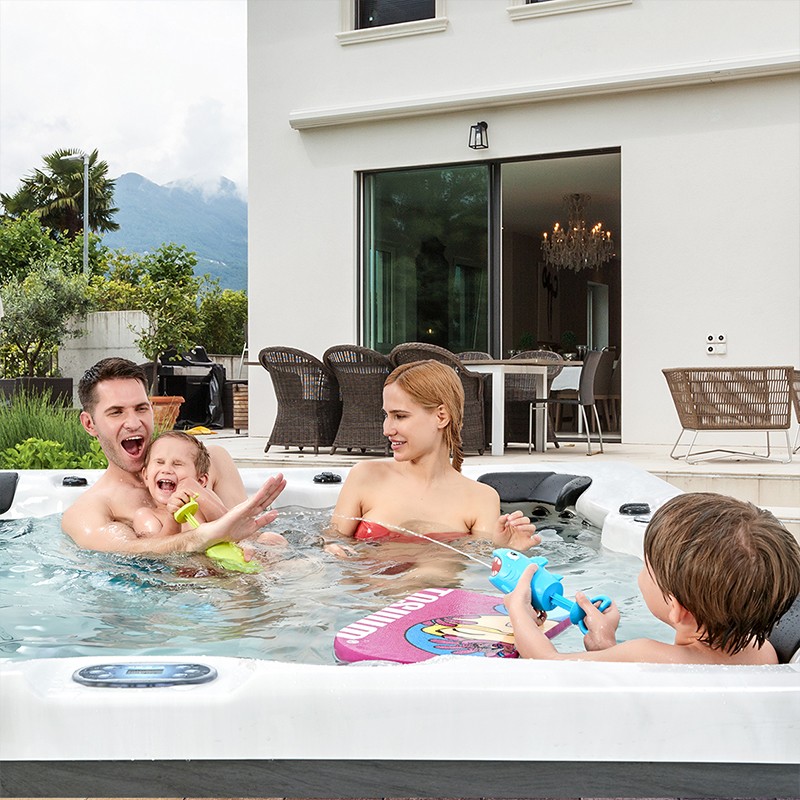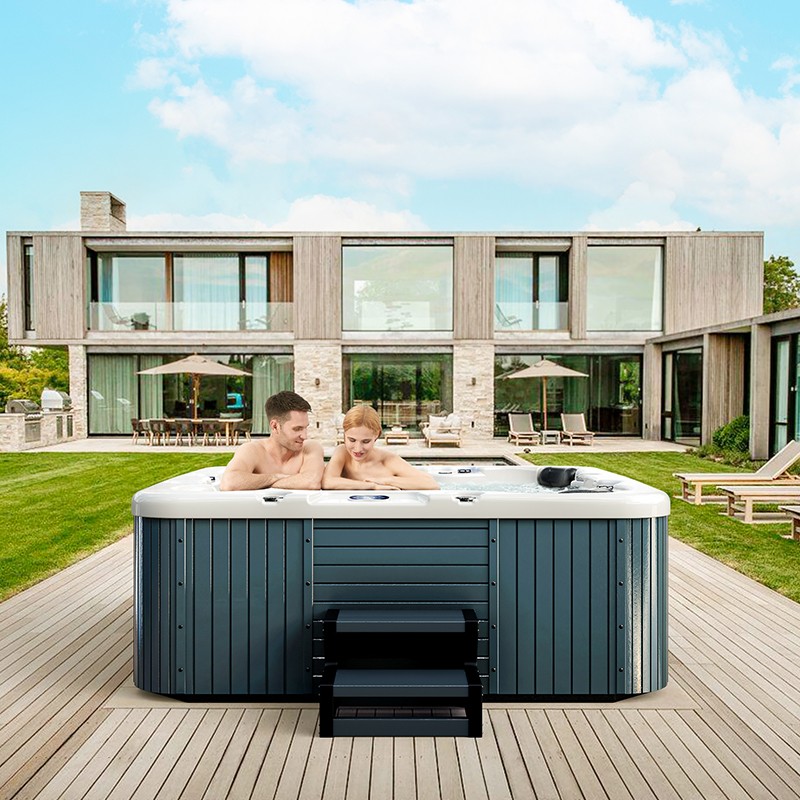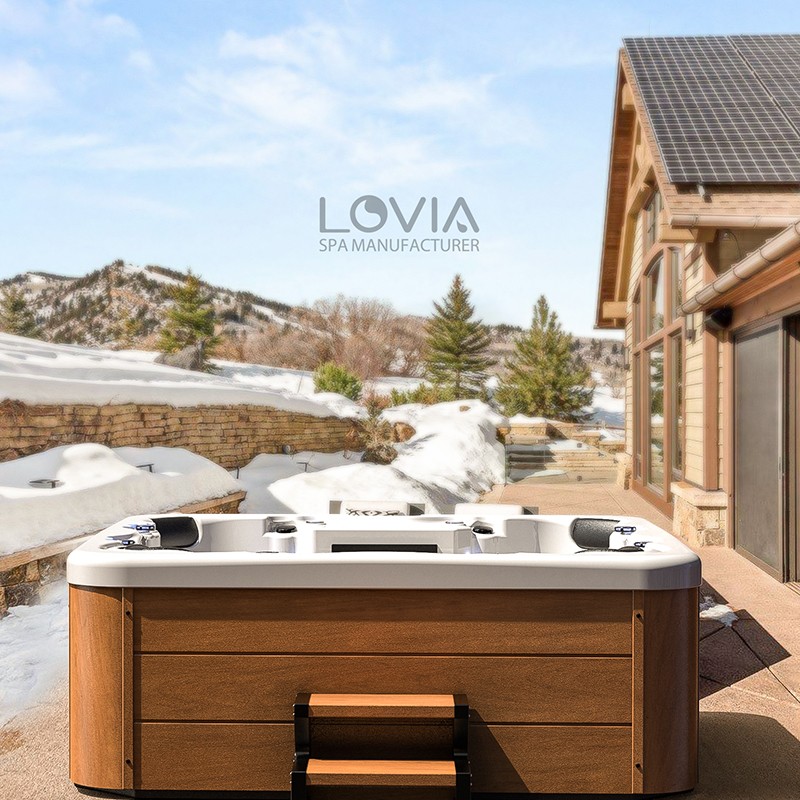
Pot umplu cada cu hidromasaj exterioară cu apă fierbinte pentru a înlocui încălzitorul?
2025-07-18 15:30· Trebuie să se bazeze în continuare pe sistemul de încălzire pentru a realiza un control constant al temperaturii.
2. În timpul unei defecțiuni temporare a încălzitoruluiDacă încălzitorul pentru cada cu hidromasaj de exterior are o problemă pe termen scurt și utilizatorul trebuie să mențină temperatura de utilizare, se poate adăuga o cantitate mică de apă fierbinte pentru a menține temperatura, dar acest lucru este doar pentru un remediu pe termen scurt și nu poate fi utilizat ca o alternativă pe termen lung.3. Măsuri antigel pe timp de iarnă
În zonele reci, utilizatorii pot folosi apă caldă pentru a ajuta la încălzirea inițială la pornirea încălzitorului, pentru a preveni înghețarea și crăparea echipamentului. Cu toate acestea, temperatura apei trebuie controlată strict în timpul acestui proces, iar sistemul original trebuie pornit imediat pentru încălzire continuă.

Prin urmare, apa caldă nu poate înlocui încălzitorul pentru cada cu hidromasaj exterioară.
Pentru întrebarea "Pot folosi apă fierbinte pentru a înlocui
cadă cu hidromasaj în aer liber
încălzitor? ", răspunsul ar trebui să fie clar:
——Nu, și nu este recomandat să faceți asta pentru o perioadă lungă de timp!
Deși injecția cu apă caldă poate fi utilizată ca auxiliar pe termen scurt în unele cazuri, această practică nu poate înlocui multiplele funcții ale sistemului de încălzire a căzii cu hidromasaj pentru spa-uri exterioare, cum ar fi temperatura constantă, circulația, siguranța și controlul calității apei. Există, de asemenea, anumite probleme, cum ar fi daune materiale, dezechilibru al calității apei, riscuri electrice și risipă economică.
Abordarea corectă ar trebui să includă:
· Folosiți întotdeauna sistemul de încălzire original;
· Întrețineți regulat încălzitorul și filtrul;
· Nu modificați circuitul și nu întrerupeți direct alimentarea după bunul plac;
· La schimbarea apei, se poate folosi o cantitate mică de asistență de încălzire, dar temperatura și metoda de injecție trebuie controlate cu strictețe;
· Dacă există o problemă, contactați producătorul sau un tehnician profesionist pentru reparații la timp, pentru a evita problemele secundare cauzate de operațiunile de înlocuire artificială.
Cum gestionați controlul calității în timpul producției?
Controlul calității la Guangzhou HuanTong Industrial este sistematic și riguros. Cei peste 20 de experți în calitate ai noștri efectuează inspecții multiple în fiecare etapă - de la selecția materiilor prime până la asamblarea finală și ambalare. Respectăm cu strictețe standardele internaționale certificate de CE, ETL și ISO9001. Acest lucru garantează că fiecare cadă spa cu jacuzzi și cadă spa de înot care părăsește fabrica noastră îndeplinește cele mai înalte standarde de siguranță, performanță și durabilitate.
Therefore, just injecting hot water once cannot replace the continuous heating, regulation and circulation functions of this system in the long term.

Is it feasible to inject hot water directly into the outdoor spa hot tub?
1. Can the hot water injection reach the target temperature?
In theory, users can inject hot water into the outdoor spa hot tub through a household water heater, boiler or other means to quickly heat up the water. However, this method has many limitations:
· Uneven temperature distribution: After the hot water is injected, it is easy to concentrate on the surface, and the temperature of the bottom layer is still low;
· Limited large-scale injection of water: The capacity of the household hot water supply system is limited, usually only 20 to 50 liters of hot water can be supplied at a time, while the volume of the bathtub is generally more than 1,000 liters;
· Time-consuming and labor-intensive to add water: It takes several consecutive injections to initially reach the ideal water temperature;
· Rapid drop in water temperature: Without the support of the constant temperature system, the water temperature drops rapidly in a short time.
Therefore, from the perspective of sustainability and efficiency, hot water injection can only be used as "temporary auxiliary heating" and cannot truly replace the complete function of the heater.
2. Risks to bathtub structure and materials
Most outdoor spa hot tubs use acrylic liner + fiberglass insulation shell structure. If hot water above 60°C is directly injected, the following damage may occur:
· Uneven thermal expansion of materials: causing deformation and cracking of the liner;
· Accelerated aging of pipes: High temperature easily causes aging of PVC or rubber water pipes;
· Damage to nozzle and pump seals: Instantaneous high water temperature affects the sealing performance of rubber rings;
· False alarm or burnout of electronic components: Some sensors mistakenly think that the system is abnormally heated and forced to shut down.
Therefore, direct high-temperature water injection without buffering and water flow distribution has a certain risk of equipment damage.

From the energy consumption analysis of spa hot tub: Does injecting hot water really save money?
1. The cost of domestic hot water supply is higher than electric heating
Users often think that "using hot water instead of outdoor spa hot tub heaters can save electricity bills", but in fact, the unit heating cost of domestic water heaters (such as gas water heaters or electric water heaters) is usually higher than that of professional spa heaters for the following reasons:
·Low efficiency: The average thermal efficiency of electric water heaters is 80%-90%, while that of spa-specific heaters is more than 98%;
·Low hot water utilization rate: A large amount of heat is lost during the water filling process;
·Must add water in batches: time-consuming and labor-intensive, and cumbersome to operate;
·Limited hot water outlet temperature: Most water heaters have a maximum temperature of 50°C~60°C, which cannot provide enough "high-temperature water" to heat the entire bathtub.
After multiple injections and cooling, users often need to use outdoor spa hot tub heaters for further heating, which is not cost-effective.
2. Adding hot water increases the burden of water bills
Hot water is equivalent to heating cold water, so the use of a large amount of hot water is inevitably accompanied by a large amount of cold water consumption, especially in areas where water resources are expensive, which will significantly increase household water expenses.
Conclusion: In the long run, using the original heating system of the outdoor spa hot tub is the most economical constant temperature solution.
Outdoor spa hot tub: Complexity of water quality management
1. Hot water injection can easily destroy the water chemical balance
Outdoor spa hot tubs are usually used in conjunction with disinfectants (such as chlorine, bromine), pH regulators, water hardness regulators, etc. The dissolution rate and reaction efficiency of each chemical are closely related to the water temperature.
After hot water injection, it may cause:
· pH value fluctuates sharply;
· Disinfectant concentration is unbalanced;
· Accelerated scale deposition;
· Increased filter load, shortening the replacement cycle;
· Water becomes turbid and breeds bacteria.
Unless the water quality is re-tested and adjusted, it will directly affect the hot tub hydrotherapy effect and user health.
2. Decreased ability to control bacteria
When the water temperature is unstable, bacteria such as Legionella are more likely to grow, especially when the water temperature is in the "bacterial breeding temperature zone" between 30°C and 37°C for a long time. The original heater can perform high-temperature sterilization functions regularly (such as setting 45°C to run for one hour), but the manual heating method cannot achieve this function.
Therefore, from a public health perspective, the direct use of hot water without water quality control is unprofessional and poses health risks.

When can hot water be used as a supplementary solution in moderation?
Although it is generally not recommended to use hot water to replace outdoor spa hot tub heaters, in the following special cases, it is possible to consider using hot water to assist operation in moderation:
1. When filling or changing water for the first time
When the spa hot tub needs to be refilled after cleaning, some hot water can be added in moderation to shorten the heating time. However, it should meet the following requirements:
· The water temperature must not exceed 45°C;
· It must be fully mixed with cold water before being injected into the bathtub;
· It must not be injected directly into the filter port or nozzle port;
· It still needs to rely on the heating system to complete constant temperature control.
2. During temporary heater failure
If the outdoor spa hot tub heater has a short-term problem and the user needs to maintain the use temperature, a small amount of hot water can be added to "maintain the temperature", but it is only for a short-term remedy and cannot be used as a long-term alternative.
3. Winter anti-freeze measures
In cold areas, users can use warm water to assist in initial heating at the beginning of the heater to prevent the equipment from freezing and cracking. However, the water temperature should be strictly controlled during this process, and the original system should be started immediately for continuous heating.
Therefore, hot water cannot replace the outdoor spa hot tub heater
For the question "Can I use hot water to replace the outdoor spa hot tub heater?", the answer should be clear:
——No, and it is not recommended to do so for a long time!
Although hot water injection can be used for short-term auxiliary in some cases, this practice cannot replace the multiple functions of the outdoor spa hot tub heating system, such as constant temperature, circulation, safety, and water quality control. There are also certain problems such as material damage, water quality imbalance, electrical risks, and economic waste.
The correct approach should include:
· Always use the original heating system;
· Regularly maintain the heater and filter;
· Do not modify the circuit or directly cut off the power at will;
· When changing water, a small amount of heating assistance can be used, but the temperature and injection method should be strictly controlled;
· If there is a problem, contact the manufacturer or professional technician for repair in time to avoid secondary problems caused by artificial substitution operations.
How do you handle quality control during production?
Quality control at Guangzhou HuanTong Industrial is systematic and rigorous. Our 20+ quality experts conduct multiple inspections at every stage—from raw material selection to final assembly and packaging. We adhere strictly to international standards certified by CE, ETL, and ISO9001. This guarantees that every spa jacuzzi tub and swim spa leaving our factory meets the highest standards for safety, performance, and durability.
· Nu trebuie injectat direct în orificiul filtrului sau în orificiul duzei;